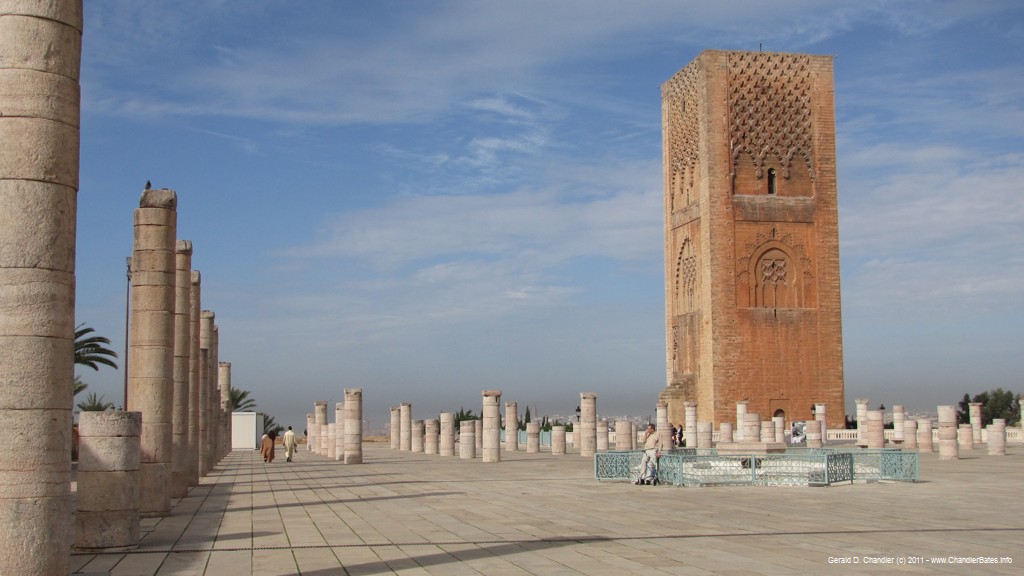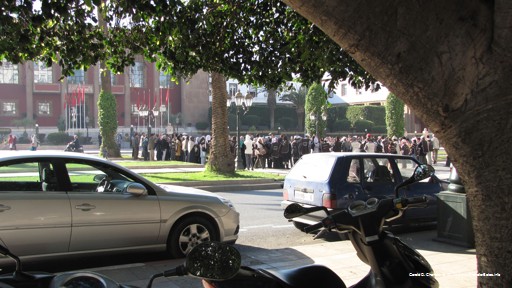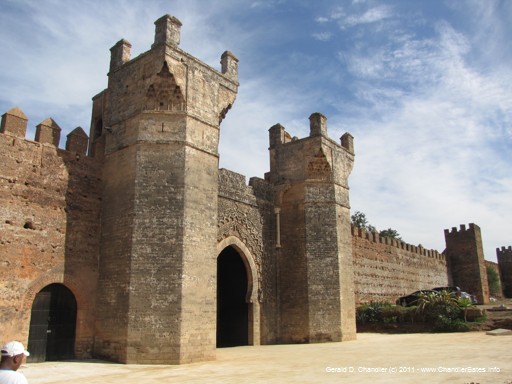Front Page | Home | Blog | Index | Site Map | Contact
![]() Marrakesh
Marrakesh
![]() Essaouira
Essaouira
![]() Casablanca
Casablanca
![]() Rabat / Sale
Rabat / Sale
![]() Chefchaouen
Chefchaouen
![]() Fez
Fez
![]() Meknes
Meknes
![]() Volubilis
Volubilis
![]() Atlas
Atlas
![]() City to City
City to City
![]() Eid Al Adha
Eid Al Adha
![]() Jan and Gerry
Jan and Gerry

2011 Frontpages & Stays
- 2011.12.23
- 2011.10.29
- 2011.07.25
- 2011.05.28
- 2011.03.31
- 2011.01.25
- Florence
- Rome
- Italy
- Paris
- Morocco
- London
2010 Fronpages & Stays
2009 Frontpages & Stays
2008 Front Pages
2007 Front Pages
2006 Front Pages
- 2006.12.12
- 2006.11.21
- 2006.11.04
- 2006.10.23
- 2006.10.09
- 2006.09.26
- 2006.09.10
- 2006.07.15
- 2006.05.30
- 2006.01.01

Tour Hassan (1195+) |
Our arrival in Rabat was quite amusing. We arrived by train and being slowpokes, we were the last to get to the end of the platform where escalators take you up to the main station. When we arrived the up escalator was blocked by two old ladies in Moroccan garb (headscarf and jelaba) who were too terrified to get on the escalator. We waited patiently and observed how a middle-aged man arrived and gave his arm to one of the two ladies and helped her on the escalator. Gerry quickly got the idea and abandoned his wife and his bags and proffered his arm in turn to the second lady who gratefully grabbed it and stepped with him onto the frightening automatic staircase! Unfortunately, Gerry took his camera with him so the event is recorded only in our memories, but it is a memory that makes us both smile. Arriving in Rabat was not only amusing but also the most trouble-free of our month-long stay in Morocoo. There were two reasons: Firstly, we arrived by train and the train station is in the center of the city. And secondly because we chose a hotel within walking distance of the train station.
In fact, it must be mentioned, that Rabat is our first city in Morocco for which we did not have a pre-booked hotel. Our previous ones, in Marrakesh, Essaouira, and Casablanca had all been booked over the web. This time we didn't find any offers we liked. Through Lonely Planet we did find one but every time we telephoned there was no answer. In Casablanca we asked the hotel to telephone for us, thinking they may have some magic understanding of Moroccan telephones but -- wow, how unhelpful -- they refused. We were told it wasn't necessary because all the hotels were nearly empty. The hotel clerk was right.
Having no hotel we started our search for a room and lunch nearby and quickly found both. We arrived around noon. While Jan sipped coffee at the station and watched the bags Gerry went off to check the offerings. By 1 pm we had our bags in our room and were sitting down to lunch just up the street from the hotel. We took the daily special and had a superb cous-cous and and almost as good tajine. How wonderful.
Later in the after noon we took a taxi the few kilometers to the Kasbah of the Udayas (or Casbah des Oudias, which is the local French version). There we were impressed by the walls, the sea view and the Skala (fortress), and not at all by the noted Andalousian Garden which was severly under cared for. This was very much a case of "you get what you pay for". There was no admission charge and thus (apparently) no money for upkeep. The opposite was true in Marrakesh at the Jardin Majorelle, where the admission price was high (by Moroccan stands, 40 Dh instead of the usual museum price of 10 Dh (= 1 Euro)). It was superbly cared for.

Rabat Coastal Fort |

Jobless Graduates Protesting |
One afternoon as we left our hotel, we heard some shouting and chanting and wondered what was happening. We walked around to the front of the hotel building and there found a group of about fifty people in a circle with placards and loudhailers. It was obviously a demonstration and as Gerry learned from one of the group, they were all young graduates, all unemployed, and all very unhappy because apparently the constitution of Morocco guarantees every graduate a job! The place where the demonstration was being held was no surprise once we learned that the large imposing building across the street from our hotel was the parliament building. After this event, we wondered if the new Moroccan constitution that has recently been approved by referendum contains the same guarantee.
Rabat, of course, is the capital of Morocco. In our three days in the city we saw no movement in or out of the parliament building. The gate was always locked. Perhaps because it was a holiday. As we noted above, Morocco has a new constitution in which the king has given up some power; perhaps because of local worries about the Arab Spring. In just 10 days (November 25) there will be elections for the parliament under the revised constitution. Maybe then the gates will be unlocked.
Rabat is to Casablanca as Washington, DC is to New York City: the first is the political capital and the second the economic headquarters of the country. Perhaps consequently there is less excitement and night life in Rabat than Casablanca. (In countries with all-in-one capitals such as London and Paris there is no need for such speculation.) Whatever the underlying reasons, Rabat is not a big tourist destination.
At first it seemed to us that in the central city neighborhood where we stayed there were few souvenir shops and tourist hotels, and tourist restaurants. But that impression came because hadn't explored very far and we hadn't explored when Rabatans are on the prowl. What are nearly empty streets in the daytime become very animated places at night. (We're looking forward to a return to Marrakesh's Jemaa el-Fnaa square to see it at night and see the reported animation there.) Secondly, the "missing" shops were just a half-dozen small blocks away. When Gerry walked through them during a night-time solo walk he couldn't avoid being offered inspection of the wares. But because we were out mostly in daylight and especially so because it was still holiday week and lots of businesses were closed for vacation, our lasting impression will be that Rabat is a sleepy town.

Archeology Museum |

Chellah |
Our first (of two) full days was devoted to history: first the Archeology Museum and then the Chellah. The museum was close enough to walk to; our time walking almost exceeded the time in the museum, it was that small. Before coming we had no idea of the Phoenecian and Roman history that preceded the Muslim Conquest; the museum added to our understanding; it had a room with some especially nice Roman bronzes.
The Chellah (pronouced to begin like either cheep or sheep, depending on the local) is consists of roman ruins and surround by the remains of a muslim fortress. Like a large park, we found it had cool and tree-shaded walks, interesting roman artefacts and some nicely carved stone muslim gates. In fact, the gardens of the Chellah were far nicer than those of the Kasbah's Andalusian Garden, We're pretty sure this is because there is a 10 Dh admission fee and thus some money to pay for gardeners.
We devoted the morning of our second full day in Rabat to a visit to the city across the river Sale which was reputed to have an amazingly authentic Medina, or walled city. We were not terribly impressed. The houses were mostly very poor looking, the streets no more attractive than the average in Morocco. The one sight that is not to be missed, however, lived up to its reputation. It is the koranic school, or medersa (madrassah in Farsi) that is located cheek-by-jowl with the main mosque of the Medina. The medersa is very highly decorated with carved stucco, carved mahogany that has aged to black, and very pretty tiled floors and columns (see the photo at the beginning of this page). Gerry climbed up to the roof and got to see the cells where students of the Koran used to live, as well as a view over the medina to the sea beyond.
In the afternoon we visited what is probably the most impressive sight in Rabat (outside the Royal palace, to which we were not invited): The Hassan Tower and the adjacent mausoleum for King Mohammed V. To get to Sale and then back to the Hassan Tower we rode the Rabat Tramway. It costs twice as much as taking the bus and shows it: all very modern and clean.
Our last morning in town turned out to be a Sunday, and surprisingly a weekend holiday in Morocco. It seemed the perfect time to wander up the road to the Catholic Church of St Peter. We arrived as the choir was finishing its practice of the day's music. We were surprised at first to see how many of the choir and of the congregation were black. Clearly there were lots of immigrants here from French West Africa, for whom French was a good lingua franca and of course they brought their religion with them. There were no doubt one or two european members of the congregation, but they were few and far between. We left just before the service was to begin, to take a last walk back to the hotel before finishing our packing and checking out to head for the bus station.